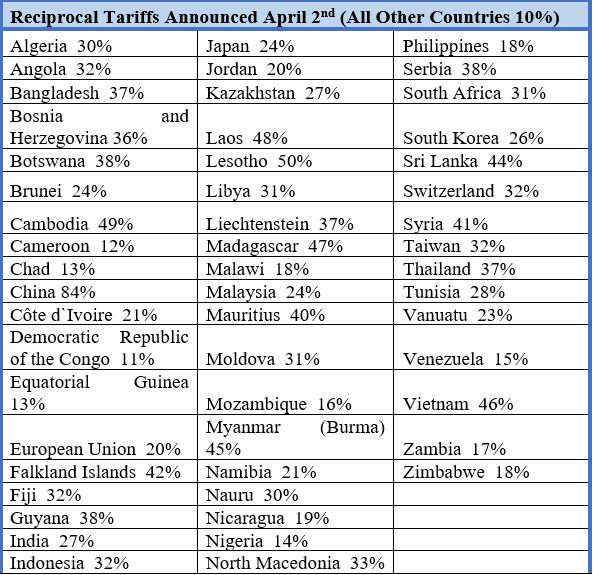This article was originally published on April 3, 2025. On April 8, 2025 the White House published a new Executive Order announcing an increase of the reciprocal duties applicable to China as of April 9, 2025, and an increase on pending duties owed on de minimis imports from China. This article is updated to reflect these changes.
President Trump has declared a national emergency due to the economic and national security risks posed by trade deficits. In response to this emergency, the President invoked the International Emergency Economic Powers Act of 1977 (“IEEPA”) along with other legal bases to exercise authority imposing: (1) a minimum universal 10% tariff on imports from all countries effective April 5, 2025; or (2) a reciprocal tariff of up to 50% on imports from specific countries effective April 9, 2025, and 84% on imports from China.
The President’s new “America First” Trade Policy and “Reciprocal Trade and Tariffs” review yielded the finding of harm from ongoing trade deficits. The loss of domestic manufacturing, risk to critical supply chains, foreign dependency of our military-industrial base, and global trading asymmetries unfairly restraining domestic interests were identified as negative effects from decades of globalization. The Trump ’47 Administration is addressing this threat by attempting to incentivize the reshoring of supply chains rather than the nearshoring (or friendshoring) that drove sourcing and production strategies during the Trump ’45 Administration. President Trump’s model is a hybrid of the universal tariffs described during the 2024 Presidential Campaign and the country-specific reciprocal tariffs described since mid-February.
This client alert summarizes immediate take-aways from the launch of the global tariff increases and assesses the supply chain impact to domestic United States companies.
High-Level Tariff Details – The new rates of duty are in addition to all other duties applicable to imported goods. Country-specific details of the new duties are shown in the table below. These duty rates were released as an Annex I in the Executive Order Regulating Imports with a Reciprocal Tariff to Rectify Trade Practices that Contribute to Large and Persistent Annual United States Goods Trade Deficits (the “E.O.”) as of April 2, 2025. Presently, rates of duty range from 10% to 50% in the E.O., though China-specific imports are subject to a duty rate of 84% as of April 9, 2025. Article-specific details identifying categories of goods not subject to the new duties were published as an Annex II to the E.O. Product-specific carveouts focus primarily on goods already subject to additional duties adjusted or imposed earlier in 2025 (e.g. automobiles and automotive parts, or steel and aluminum products). Copper, pharmaceuticals, semiconductors, lumber articles, energy, and certain minerals unavailable in the U.S. are also found in Annex II. Effective dates exclude goods loaded onto vessels and in transit on the final mode of transportation as of April 5 or April 9 (as appropriate) and entered for consumption or withdrawn from warehouses for consumption after the April 5 or April 9 date.

Canada and Mexico Impacts – The pre-existing rules on imports from Canada and Mexico remain largely untouched by this new action. Goods qualifying for duty-free status under USMCA will remain eligible for duty-free entry. Goods from Canada and Mexico that do not qualify for duty-free status are subject to 25% ad valorem duties (or 10% in the case of energy and potash). If the prior rules on Canada and Mexico imports are revoked, then a savings clause provides for the levels of duties that will apply, which is 12% under the E.O.
China Transshipment and Evasion Risk – The new ad valorem rates applicable to China will also apply to imports from the Hong Kong Special Administrative Region and the Macau Special Administrative Region. This feature is intended to reduce the risk of transshipment through those regions for purposes of duty evasion.
Duty-Free De Minimis Entry – Duty-free low-value de minimis imports from most countries are not immediately impacted by this action, although this will change over time. Duty-free entry will cease to be available once technological systems capable of processing and collecting duty on de minimis items become available. However, low-value imports from China will lose their duty-free status on May 2, 2025. Postal items from China that would otherwise qualify as de minimis are subject to a duty rate of either 90% of their value or $75 per item, increasing to $150 per item after June 1, 2025. These duties will be in lieu of other duties, such as the 20% ad valorem duties announced last quarter and Section 301 duties. Carriers transporting postal items must report shipments to CBP, remit required duties, and maintain an international carrier bond. CBP may choose to require formal entry.
Potential for Future Change – The President reserves the right to increase rates of duty in response to any retaliation by trading partners. Rates of duty could decrease if significant steps to reduce trading barriers are taken by trading partners.
Top Supply Chain Impacts – Two key facts that the Benesch team has reported since Thanksgiving Week of 2024 ring true. First, we are entering a higher cost operating environment for those whose supply chains rely on import goods and possibly for those who sell in export markets. Second, the only risk-free sourcing geography is at home in the United States. These are the business realities in which we operate.
Top Supply Chain Strategies – Options exist for managing the challenges presented by these supply chain impacts. Near-term tactics for limiting exposure of eroding margins are top of mind, followed by longer-term procurement and sales strategies. The go-to strategy across industries in recent months has been giving notice and opening negotiations with suppliers and customers while building the contractual and workflow infrastructure necessary to accommodate price or volume changes. Creative logistics options such as the use of customs bonded warehouses or foreign trade zones to better manage duty outlays can help relieve cashflow. Confirmatory compliance exercises remain prudent, such as mapping supply chain product flows, true countries of origin, tariff codes and net duty burden, as well as the documentation necessary to substantiate those facts in the event of regulatory enforcement by U.S. Customs and Border Protection. Longer-term, alternate domestic supply or less costly foreign supply may be available to the procurement teams of some importers.
Benesch client alerts and legal publications are available for you to receive by signing up HERE. Our team is responsive and available to assist with your company’s supply chain management challenges.
Jonathan Todd is Vice Chair of the Transportation & Logistics Practice Group at Benesch Law. He may be reached by telephone at 1-216-363-4658 or by e-mail at jtodd@beneschlaw.com.
Vanessa Gomez is an Associate with Benesch Law. She may be reached by telephone at 1-216-363-4482 or by e-mail at vgomez@beneschlaw.com.
Meg MacCallum is an Associate with Benesch Law. She may be reached by telephone at 1-216-363-4185 or by e-mail at mmaccallum@beneschlaw.com.
